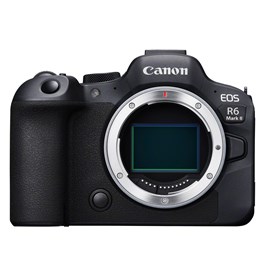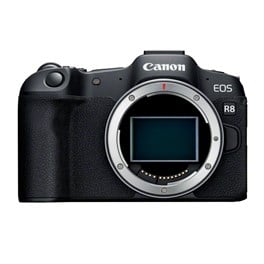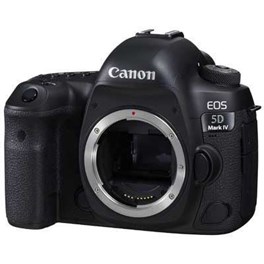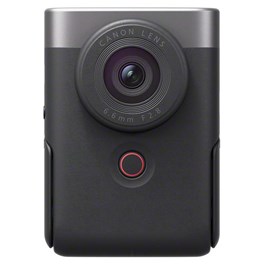
Canon, deservedly, is one of the most well-known names in photography and video. Its ranges of mirrorless, DSLRs, cinema cameras, camcorders, compacts and specialist cameras have won awards, not to mention legions of fans, and if you want one of the best imaging setups in the business, the Canon ecosystem is a tremendous place to start.
At Wex our team regularly test and review the latest Canon gear, on the site and on our YouTube channel. The cameras on this list are ones that have particularly impressed us. We’ve not just picked the fancy pro stuff – we also have included plenty of Canon’s entry-level cameras, as this area is in fact one of the firm’s real strengths.
Amateur, professional, enthusiast, or all three – you’ll find a great Canon camera here for you. We’ve divided our list into categories to make it easier to navigate, and have included a fair, honest assessment of the pros and cons of each camera, so you know what you’re getting into.
Best Canon Mirrorless Camera
Canon’s flagship EOS R mirrorless range is currently the jewel in the crown. Throughout the series there are cameras for every user, including beginner-friendly options with budget prices, and professional-grade cameras on the cutting edge, and everything in between. We’ve picked a few of our favourites here, but more mirrorless models show up throughout the other categories on this list.
We’re exclusively covering Canon’s EOS R series throughout this guide, including both full-frame and APS-C models. Some of the finest, most spectacular cameras ever made are on this list, as well as some highly capable (arguably underrated) all-rounders that would make a perfect purchase for any committed photo or video enthusiast.
Best professional all-rounder:
|
Pros:
Cons:
|
Sensor: 45MP full-frame CMOS Lens Mount: Canon RF mount Video: 8K/60p, 4K/120p ISO Range: 100–51,200 (expandable to 102,400) Stabilisation: In-body 5-axis image stabilisation (IBIS) |
Quite possibly the finest high-resolution all-rounder camera ever made, the Canon EOS R5 Mark II is a slam-dunk for professionals, especially those who shoot both stills and video. Like the original R5, it shoots 45MP stills and 8K video, however the big addition here is the DIGIC Accelerator processor, which improves operational speeds to allow for 30fps stills shooting and 60p 8K video.
Elsewhere on the camera you get next-generation features like Canon’s Eye Control AF, which sets the autofocus point in the frame by the position of the user’s eye in the viewfinder. Alternatively, there’s the highly capable and tenacious subject-detection system which can identify and lock onto specific subjects. If you know the specific individuals you’re going to be photographing, you can even set the camera to find and lock onto them in order of priority. A groundbreaking camera in many respects, the Canon EOS R5 Mark II sets new benchmarks in its uncompromising offer of speed and quality.
Best enthusiast all-rounder:
|
Pros:
Cons:
|
Sensor: 24.2MP full-frame CMOS Lens Mount: Canon RF mount Video: 6K ProRes RAW (external), 4K/60p (oversampled) ISO Range: 100–102,400 (expandable to 204,800) Stabilisation: In-body 5-axis image stabilisation (IBIS) |
There’s a case to be made that the Canon EOS R6 Mark II is one of the best digital cameras for enthusiasts ever made. It’s definitely priced at the upper end for non-professionals, but if it fits your budget, you’ll find an utterly superb camera for pretty much anything. Its Dual Pixel CMOS AF II system simply gets the job done in any situation; its 24.2MP full-frame sensor produces brilliant, vibrant images; and its stabilisation system can be paired with a stabilised RF-mount lens to deliver a whopping eight stops of effective compensation.
The EOS R6 Mark II boasts two slots for fast UHS-II SD cards – a more affordable format than CFExpress, but still fast enough to keep up. Video-wise, it captures great-looking 4K using the full width of its sensor – no cropping here. You can even up that to 6K ProRes if you pair the EOS R6 Mark II with an external recorder.
Best mid-range mirrorless:
|
Pros:
Cons:
|
Sensor: 24.2MP full-frame CMOS Lens Mount: Canon RF mount Video: 4K/60p (oversampled from 6K) ISO Range: 100–102,400 (expandable to 204,800) Autofocus: Dual Pixel CMOS AF II with subject detection |
A wunderkind at stills and video alike, the Canon EOS R8 is an impressively specced camera when you consider the fact that it weighs just 461g. It’s designed as a kind of “step-up” camera for users who are looking to upgrade to full-frame, and as such it’s one of the more affordable full-frame models in Canon’s line-up. It blends high-quality stills shooting with impressive speeds – 30fps in raw is nothing to sneeze at – and there’s also a solid video spec. It can shoot 4K video at 60p, and there’s also the Canon Log3 profile for maximising dynamic range.
Granted, a few sacrifices have been made to keep the camera so light. There’s only one card slot, which could prove an issue on an intense shoot, and there’s no in-body stabilisation system, meaning you’ll need to rely on lens-based IS.
Best Canon DSLRs
Canon knows what it’s talking about when it comes to DSLRs. Over the years it has been responsible for some of the most iconic DSLR cameras ever made. From the EOS 5D series, which famously caused a mini revolution in filmmaking, to the sporty speedster EOS-1D X series, Canon has made its mark on the photography world with some absolutely superb DSLRs.
While mirrorless is more in vogue these days, many photographers still prefer DSLRs for their optical viewfinders, rugged bodies and long battery life. The Canon EF lens line is also one of the most extensive in the business, replete with Canon-made and third-party lenses alike at a range of different prices. While DSLRs also crop up in some of the other categories on this page, here we’ve highlighted two in particular that deserve your consideration.
Best professional Canon DSLR:
|
Pros:
Cons:
|
Sensor: 30.4MP full-frame CMOS Lens Mount: Canon EF mount Video: 4K/30p, Full HD 1080p/60p ISO Range: 100–32,000 (expandable to 50–102,400) Autofocus: 61-point phase-detection AF |
The EOS 5D series of DSLRs basically revolutionised filmmaking in the 2000s, and the series’ most recent and likely last model upholds that fine tradition. It produces high-quality 4K video at 30fps and can shoot Full HD video at 120fps for super slow motion.
Having the full-frame sensor and the EF mount gives you access to the huge range of Canon lenses, meaning practically any imaging vision can be realised, and it’s of course no slouch for stills either, boasting the ability to shoot at a maximum ISO sensitivity of ISO 32,000. For real hybrid shooting, it can even extract 8MP stills from 4K video, allowing you to effectively shoot both at once.
Bear in mind this camera was a fairly incremental upgrade over its predecessor, the EOS 5D Mark III. So, if it’s out of your budget, it’s worth checking out our Used section to see if any of the older cameras are available at a cheaper price.
Best Canon DSLR for enthusiasts:
|
Pros:
Cons:
|
Sensor: 24.1MP APS-C CMOS Lens Mount: Canon EF/EF-S mount Video: Full HD 1080p/30p, HD 720p/60p ISO Range: 100–6,400 (expandable to 12,800) Dual Card Slots: Single UHS-I SD |
If you’re looking for an affordable entry into DSLR photography, the Canon EOS 2000D (also known as the Rebel T7) is a solid choice. With a 24.1MP APS-C sensor, it captures detailed images that are a noticeable step up from smartphone photography. Its built-in Wi-Fi and NFC make transferring photos a breeze, allowing you to share your shots quickly and easily.
The optical viewfinder offers a traditional DSLR shooting experience, while Canon’s intuitive guided interface helps beginners get to grips with manual controls. Battery life is also strong compared to most mirrorless alternatives, making it a reliable option for a day’s shooting.
That said, there are some limitations. The autofocus system is relatively basic, with just 9 AF points, which can feel restrictive for action or low-light photography. Video capabilities are also limited, as it only shoots in 1080p at 30fps, rather than the 4K offered by more advanced models.
Still, if you’re after an affordable and easy-to-use DSLR to start your photography journey, the Canon EOS 2000D is well worth considering.
Best for Canon cameras for beginners
All this technical talk flying over your head? Canon is, for our money, offering some of the best systems around for beginner photographers and videographers. Its DSLR and mirrorless ranges include multiple entry-level options, it has plenty of affordable lenses, and many of its cameras come with handy guided modes to help new users get the best out of them.
There are beginner options in Canon’s mirrorless and DSLR lines. And, for those who just want a camera for fun, Canon also offers some knockabout instant-print cameras that can spit out physical copies of images – great for families and parties alike. In this section, we’ve selected some Canon cameras that are particularly suited to beginner shooters, whether you’re a novice who’s keen to learn, or just someone who wants to have fun snapping pictures.
Best beginner Canon mirrorless:
|
Pros:
Cons:
|
Sensor: 24.1MP APS-C CMOS Lens Mount: Canon RF/RF-S mount Video: 4K/25p (1.55x crop), Full HD 1080p/60p ISO Range: 100–12,800 (expandable to 25,600) Autofocus: Dual Pixel CMOS AF with Eye Detection |
The Canon EOS R100 is the cheapest EOS R camera you can currently buy. Essentially, it’s a replacement for Canon’s popular beginner DSLRs, designed for photography students and newbies, and it fulfils that function brilliantly. While it doesn’t offer as many features as the more expensive options, it still has that winning 24.2MP APS-C sensor – so you’re still getting great image quality, even from a beginner body.
Benefiting from Dual Pixel CMOS autofocus across 88% of the frame, the EOS R100 is a pretty credible camera when it comes to moving subjects. If you want to shoot discreetly, you can activate Silent Mode, and there are also some useful Hybrid Auto modes to help guide you to the best settings for any given shooting situation. You can also connect it to your smart device via the built-in Wi-Fi or Bluetooth connection options, which is a great way to play around with remote shutter triggering.
Best Canon instant camera:
|
Pros:
Cons:
|
Sensor: 8MP CMOS Lens: Fixed focus, f2.2 Print Technology: ZINK (Zero Ink) printing Photo Size: 2x3-inch prints Connectivity: Bluetooth with Canon Mini Print app |
And now, for something completely different (well, mostly different). The Canon Zoemini S2 is one of Canon’s instant print cameras. Exactly as they sound, these clever little point-and-shoots are capable of spitting out a physical print of your image within seconds of pressing the shutter. They use Canon’s Zink (zero-ink) paper to create sticky-back prints about the size of a credit card.
The 8MP files are also recorded digitally to an SD card. While the camera doesn’t offer any kind of settings control, it’s extremely simple to use, and is therefore ideal for families and children. You can also use the Bluetooth connectivity to connect it to Canon’s Mini Print app, which gives you extra customisation options such as the ability to add text and stickers. Weighing just 188g, this is a camera that’s easy to carry everywhere with you – it’s excellent for making memories at parties and on holidays.
Best Canon cameras for video
From kickstarting the Hollywood DSLR revolution to expanding its impressive line of pro cine cameras, Canon has very much made its mark in the video space. Vloggers, filmmakers, documentarians and streamers can all find something suitable for their purposes in the various Canon lines, with options to suit all budgets.
We’ve mostly stayed away from the ultra-expensive stuff in this section, and have confined our picks to cameras that will most likely be useful to a majority of prospective video shooters. If you do want something more high-end, the EOS R5 in our mirrorless section is a good choice, as is the EOS 5D Mark IV in our DSLR section. Pro video users, meanwhile, will want to look at the Canon Cinema range.
Best Canon camera for streaming:
|
Pros:
Cons:
|
Sensor: 20.1MP 1-inch CMOS Lens: 24–100mm equivalent (f1.8–f2.8) Video: 4K/30p, Full HD 1080p/120p ISO Range: 125–12,800 (expandable to 25,600) Live Streaming: Direct YouTube live streaming |
One of the most popular cameras for vloggers, the Canon PowerShot G7 X Mark III is an all-in-one compact that offers loads of great video features without skimping on stills. Producing 4K movies and offering a mic input and a tilt-up screen that makes it easy to self-shoot, the G7 X Mark III also can make use of its Bluetooth and Wi-Fi connectivity to livestream movies directly to online platforms like Facebook, Twitch or YouTube. The 20.1MP sensor ensures gorgeous, dynamic results no matter what you’re shooting.
In terms of downsides, naturally using a compact camera rather than an interchangeable-lens system does limit you in terms of versatility. There's a little softness at the wide end of the G7 X Mark III's lens, and it's also worth being aware that 4K shooting is capped at ten minutes.
Best Canon camcorder:
|
Pros:
Cons:
|
Sensor: 1/2.3-inch CMOS Lens: 20x optical zoom (29.3–601mm equivalent, f1.8–f2.8) Video: 4K/25p, Full HD 1080p/50p Stabilisation: 5-axis optical and electronic stabilisation Recording Media: Dual SD card slots |
If you’re only looking to shoot video and have no interest in stills, then a Canon camcorder could be a better buy than a DSLR or mirrorless camera. The Canon Legria HF G70 is a good choice – an all-in-one model with a 20x zoom lens that makes use of a 5-axis optical stabilisation system for super-smooth footage. The Legria HF G70 can capture 4K UHD 150Mbps at 25p, and features a 3.5mm microphone jack input in addition to its built-in mic.
Weighing in at 740g, the camera is light enough to be operated one-handed. While it’s not weatherproof, its feature-set make it well-suited to run ‘n’ gun shooting, and it doesn’t do too badly in low light thanks to an f1.8-2.8 maximum aperture on its lens. The camcorder also benefits from some of Canon’s autofocus advancements, including Face Detection AF and Face Tracking.
Best Canon vlogging camera:
|
Pros:
Cons:
|
Sensor: 20.9MP 1-inch CMOS Lens: Fixed 19mm equivalent (f2.8) Video: 4K/30p, Full HD 1080p/60p Audio: Built-in stereo microphones with noise reduction Live Streaming: Direct YouTube and Facebook streaming |
went back to the drawing board with its PowerShot range. It started to produce interesting, specialised cameras designed to excel at specific functions rather than being generalists. And so, the PowerShot V10.
It’s a vlogging camera – but more so. Lots of cameras are billed as “vlogging specialists” these days, but the V10 is specifically designed to be comfortably held in the palm of the hand for self-filming. It’s a much more natural fit than trying to hold a conventional camera in one hand and point it at yourself – and the V10 also has a built-in kickstand, meaning you don’t need to mount it to a tripod to go hands-free.
The 4K 30p video it produces looks great – however, it’s a good idea to pick up a high-spec microSD card [https://www.wexphotovideo.com/microsd-cards/] to ensure the camera can keep up. Otherwise, you can find yourself struggling against limited recording times.
Best Canon cameras for travel
Plenty of Canon cameras are lightweight, portable and capable – which is great news if you’re looking for something travel-friendly. Travel photography is all about balancing your needs with what’s sensible to pack – you may want an all-in-one compact camera for ease, however, a mirrorless camera with a selection of small lenses can give you much greater versatility.
As such, we’ve given you a little of both in this final section. Remember that there’s plenty of overlap between categories, and other cameras that have already featured could easily have earned a place here, such as the ultra-light full-frame EOS R8, or the nippy PowerShot G7 X Mark III compact camera.
Best Canon mirrorless for travel:
|
Pros:
Cons:
|
Sensor: 24.2MP APS-C CMOS Lens Mount: Canon RF/RF-S mount Video: 4K/60p (cropped), 4K/30p (oversampled from 6K) ISO Range: 100–32,000 (expandable to 51,200) Autofocus: Dual Pixel CMOS AF II with subject tracking |
The Canon EOS R10 sits at a spot in the EOS R lineup that makes it ideal for travelling photographers. As an APS-C camera, it’s both lighter and more affordable than the big full-frame boys – however, it comes with a suite of tasty features that make it versatile and capable. Its autofocus is whip-fast, as is its burst rate – switch to the silent electronic shutter and you can go as fast as 30fps! It also comes equipped with a number of dedicated shooting modes, like Panoramic Shot for capturing sweeping vistas.
The autofocus also benefits from Canon’s deep-learning system. This means it has automatic subject recognition, and can lock onto people, animals and vehicles with impressive accuracy. There’s a wide selection of lenses available, especially if you’ve got the budget for an EF-EOS R adapter – looking for a lens with built-in stabilisation might be a good idea, as the EOS R10 lacks a built-in stabilising system of its own.
Best Canon camera for birding:
|
Pros:
Cons:
|
Sensor: 12.1MP 1/3-inch CMOS Lens: Fixed 100mm and 400mm equivalent (digital zoom to 800mm) Video: Full HD 1080p/30p ISO Range: 100–3,200 Stabilisation: Optical image stabilisation (OIS) |
Another example of Canon retooling its PowerShot range into highly specialist cameras, the PowerShot Zoom is a rather interesting little number. It’s essentially the biggest possible zoom in the smallest possible format, designed for wildlife enthusiasts, birdwatchers and anyone else who’d benefit from being able to see (and record) things that are a long way away. Its tiny dimensions make it also a good choice for travel.
Its optical zoom lens extends to an equivalent of 400mm, and with the Digital Zoom functionality, this can be extended to an equivalent of 800mm! Helping make this useable is a built-in 4-axis optical stabilisation system, which means you can leave the tripod at home. The PowerShot Zoom records stills at 12.1MP and video in Full HD – not the highest resolutions, but sufficient for recording clear imagery of any wildlife you spot. It’s great for hikes and days out – but can also be a good companion for sporting events, especially if you’re seated all the way out in the nosebleeds. This versatility is what makes it a worthy travel companion.

FAQs
How do I update the firmware on my Canon camera?
Updating your firmware is easy. To update the firmware on your Canon camera, visit the Canon website and find the support section. Find your camera model and download the latest firmware update file. Follow the instructions provided by Canon to install the firmware update onto your camera.
What lenses are compatible with my Canon camera?
Canon DSLR cameras use the EF or EF-S lens mount. EF lenses are compatible with both full-frame and APS-C sensor cameras, while EF-S lenses are designed specifically for APS-C sensor cameras. Additionally, Canon's mirrorless cameras use the RF lens mount. Be sure to check your camera's lens mount specifications before purchasing a lens.
How should I clean my Canon camera sensor?
If you decide to clean your sensor yourself, you must take extreme care. Use a blower to remove loose dust particles, then use a sensor cleaning swab and cleaning solution specifically designed for camera sensors. Follow the manufacturer's instructions carefully to avoid damaging the sensor.
How do I choose the right Canon camera for my needs?
You need to consider several factors such as your budget, type of photography (e.g., travel, portraits, sports), features (e.g., resolution, autofocus capabilities, video recording), and future upgrade paths. Research different models, read reviews, and if possible, try out cameras in person to find the best fit for your requirements. You can always visit one of our many stores for guidance and to try out any cameras.
How do we decide?
Our in-house photography experts, store staff and partners all work collaboratively to pour over our guides and tips articles. We also consider emerging trends and customer feedback to make sure our guides are always up-to-date and reflective of what people are truly looking for. By curating only the best products, our guides provide trustworthy recommendations, making it easier for customers to make informed choices with confidence.
If you would like more advice on any purchase our contact centre staff are here to help. Alternatively, you can reach us via email or social media. And don't forget. If you were to purchase anything based on our recommendations you'll be covered by our full returns policy


















